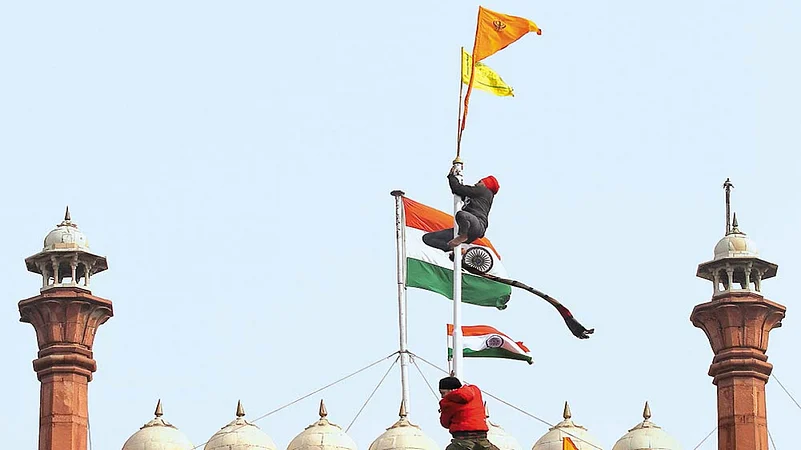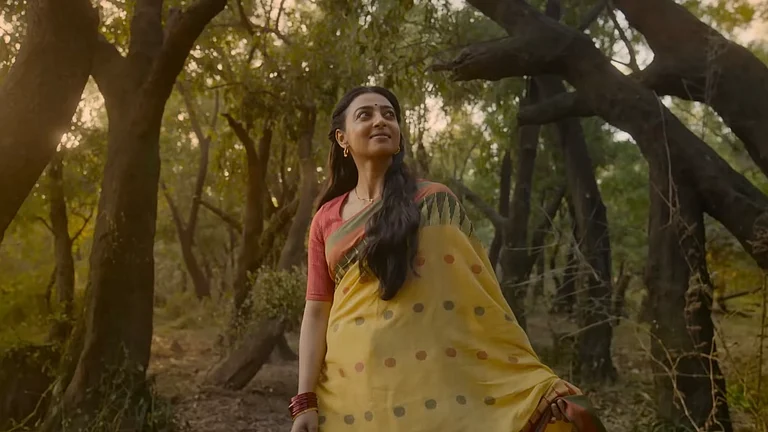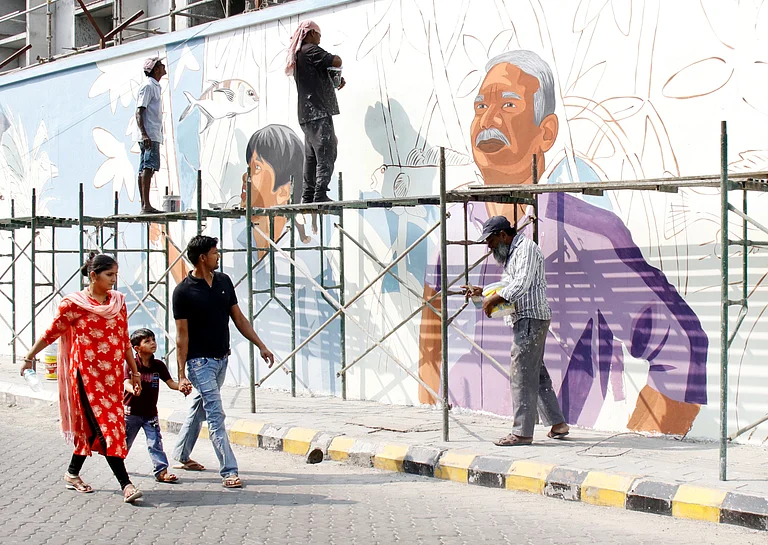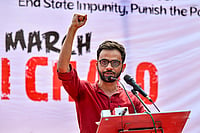Every conflict contains within itself the seeds of its own resolution. To see those affirmative signs, one may only need to amend the framing narrative, and enable it to fulfil its own potential. In this case, it’s about the Republic of India and what it says to itself through symbols and metaphors. India is a country that overthrew the most systematic form of oppressive power known to history—colonialism—without war. By doing so, it took power away from an illegitimate holder and restored it to the people. People are not illegitimate. They are the cells and nerves of this body politic. They are the republic. Once we grant that, we will not be detained by saboteurs, by conspiracy theorists, by centrists or rightists or leftists, by media parakeets or sensation-mongers.
Did the Sikh flag known as Nishan Sahib go up at Red Fort on January 26? Yes. Who put it up? There are stories and stories. Whoever did, it came to have a meaning. Did they displace the Indian flag? No. Is it okay for a religious symbol to be fluttering at a site that has come to be adopted by the Indian state as a metaphor for nationhood, despite a complicated and disputed history? Not necessarily. Did India’s new Parliament building project get inaugurated with religious symbolism? Yes, just the other day. A debate over which was more legitimate (or not) is not what India needs. There are more vital issues at stake, to do with livelihood.
The tractor rally on Republic Day came at the end of a two-month-long farmers’ movement—a strikingly durable and cohesive affair, judging by the numerous and disparate actors who are part of it. An ‘actor’ called Deep Sidhu does not describe them. But he took the lead role in producing a situation that became an inflection point for the movement—indeed, for India’s democracy itself. At the end of the day, the Nishan Sahib, the religious flag of Sikhs, was fluttering alongside the Tricolor at Red Fort. The streets of Delhi saw some violence as the police and protesters—children of the same social universe—encountered each other in a drama over the formal procedures of permission or its absence. Unprecedented scenes were witnessed as tractors—the very symbol of India’s green revolution—moved past barricades, attacking police personnel who came in their way, as they moved towards the symbolic heart of New Delhi. Under strict orders not to open fire, over 300 policemen sustained injuries. Many of them got multiple fractures, jumping into the moat from the Red Fort ramparts to escape violent agitators. They put themselves at risk to maintain law and order—vulnerable, and visible, in a way they were not when violence raged in the Capital a year ago. Or visible only in less than flattering ways. That was at the end of the anti-CAA agitation, a remarkably similar episode of India’s citizenry speaking to its government. Being Muslim-led, that was more vulnerable to popular characterisations of ‘anti-nationalism’. An allegation slightly more difficult to sustain when protesters come from the heartland of western UP, Haryana and Punjab.

Injured policeman taken away.
But Punjab provides an opening. Talk of ‘pro-Khalistan’ elements having infiltrated the farmers’ protest is in the air. The name of a US-based secessionist organisation, Sikhs for Justice (SFJ), has come up. The SFJ had given a call to the protesting farmers on January 11 “to raise the Khalistan flag at India Gate” on Republic Day and had offered a reward of US $2,50,000 to whoever does it, with the promise to help the person resettle in the UK as a refugee. This is where the name of Punjabi actor-singer Deep Sidhu comes in. He’s the one who handed the ‘kesri’ flag to the man who climbed the pole at Red Fort. Who is Sidhu? A bundle of contradictions. A young Punjabi singer-actor who managed to mouth words on TV that seemed to express a vein of anarchism that even the far left has long discarded, with touches of Khalistani nationalism. And all that just a year after being actor-turned-BJP MP Sunny Deol’s aide during the 2019 Lok Sabha elections, possessing a photo that has him and Deol posing with none other than the prime minister. In between, he also managed to get on the radar of the National Investigation Agency (NIA) in connection with a case filed against the SFJ on December 15. Far left? Anarchist? Khalistani? Saffron? It doesn’t really matter. The only lesson here is that a gadfly who loves to put himself in the news (and in photographs with important people) cannot be used as a benchmark for India’s farmers.
And yet, the unfortunate happenings of January 26 have affected the farmers’ protest, one that had remained peaceful for over two months. The farmers—many of them old and infirm—had won public sympathy as they braved north India’s bitter winter out in the open with plenty grit. Their resolve to remain peaceful was their strength. Even the BJP acknowledges that. “The farmers remained adamant even after the government offered to keep the laws in abeyance for 1-1.5 years, but they still had people’s support. The violence has been a self-goal for them. It will be very difficult for them to bring their movement back on track,” says a senior party leader.

Cornered policemen beg for mercy.
That could be an expression of the scepticism that reigns on the other side of the fence, even if cast in charitable words. But it puts a finger on the problem. The farmer leaders are still trying to figure out how things went so horribly wrong. Some 37 of them have been named in an FIR, including Rakesh Tikait—son of Mahendra Singh Tikait, the farmer leader from western UP who put the Bharatiya Kisan Union on India’s map during the 1988 protests—and Yogendra Yadav of Swaraj India, who arrived at the helm of these protests with a very different political history. Several well-known people, including Congress leader Shashi Tharoor and journalist Rajdeep Sardesai, have been charged with sedition for allegedly spreading violence through social media posts. Some unions, like the All India Kisan Sangharsh Coordination Committee and farmer leader V.M. Singh have withdrawn support from the protests, others also weighing their options. It is clear that a wedge has been driven in the movement. Announcing his withdrawal from the movement, Singh blamed Rakesh Tikait for misleading protesters and going back on the agreement with the Delhi Police regarding the route to be followed. Tikait, meanwhile, claims the Delhi Police had wrongly placed barricades at some places of pre-decided routes.
Sources say the Delhi Police—on whom even the Supreme Court left the decision on whether the tractor rally should be allowed—was not in favour of granting permission. They would be under too much pressure anyway, handling security on the crucial day. Not to speak of intelligence inputs warning about “some elements” among the agitators, a familiar trope that inevitably brought Pakistan into the debate. Delhi Police Commissioner S.N. Shrivastava expressed his reservations in a series of meetings with the Home Ministry. However, it was a political decision to allow the tractor rally rather than risk more confrontation with angry, determined farmers. Former Delhi Police commissioner Neeraj Kumar believes there weren’t many options before the government. “There’s no way you could have restrained them. The only way would have been to open fire, which would have had serious repercussions. But non-lethal methods—water-cannons, teargas shells, lathicharge—did not work,” he says.

Roads to central Delhi was blocked by barriers; farmers used their tractors to breach them at Shahdara (left) and Ghazipur.
The strategy, he says, would have been to spread the protesters thin by allowing them in from three points, but that ensured the police were spread thin too. “There’s a limit to the security force you can deploy on Republic Day. But what happened at Red Fort was reprehensible,” says Kumar. He finds it tragic that the agitators used lathis with the national flag to beat policemen. “There are no easy answers to what happened and whether it could have been prevented. I don’t envy the CP for the position he finds himself in,” he adds.
In the event, the sheer numbers caught everyone off-guard—the police and even the farmer leaders. The latter had some intimation—at least by the afternoon of January 24. But while the overwhelming response brought cheers to farmers camping at Delhi’s borders, it was a problem for those working out the details. But even they were thinking logistics, not law and order.
“No other protest in history has ever been as widespread, yet as peaceful as ours,” says Hannan Mollah, general secretary of the CPI(M)-backed All India Kisan Sabha (AIKS). “We condemn and regret such acts and dissociate ourselves from it. Some outsiders wanted to disrupt our peaceful process,” he adds. Dinesh Kulkarni of the RSS-affiliated Bharatiya Kisan Sangh (BKS) looks askance at that stand. “What’s the use of disassociating yourself or condemning an act after it has been committed?” he asks. The BKS does not want the government to repeal the laws but has strong views on them. It’s pressing for MSP to be secured by a new legislation or an amendment to the existing one, for traders to be registered, for agriculture courts in all districts and for corporates to be kept out of the definition of ‘farmer’. The government, says Kulkarni, has been sensitive and patient enough, as the 11 rounds of talks prove. “They even agreed to hold back the laws for 18 months,” he says, “but the protesting farmers even refuse to speak with the committee set up by the apex court.”

The chaos in Delhi’s ITO, seen through the cracked windshield of a damaged car.
A senior BJP leader admits the farmers had popular support till January 26. That’s why the RSS intervened and nudged the government to find a “middle ground”—that’s how the offer to keep the laws in abeyance came about. “However, the violence has been a self-goal,” he says. Ashwani Mahajan, co-convener of Swadeshi Jagaran Manch (SJM), another Sangh outfit, says the anarchy witnessed on Republic Day is not healthy in a democracy. “The government was being reasonable and flexible. Bringing in lakhs of people in an agitating mode was absolutely uncalled for. The farmers should have accepted the offer of suspending the laws. They too have to be receptive and cannot insist on repeal of laws. They lost an opportunity to find solutions,” he tells Outlook.
It’s natural that the BJP, finding itself on the wrong side of a popular protest coming out of the heart of rural north India, is ambivalent about the core issues—even if the RSS shares some of the farmers’ concerns. But the government has a point, and has derived a moral advantage in a situation where it was scarce. “The onus now rests with the union leaders to convince the Supreme Court that they were not responsible for the violence in Delhi and that ‘outsiders’ had hijacked their peaceful rally,” says a senior government functionary. The farmer leaders too are aware they have lost an edge they had. Those spearheading the agitation are back at the drawing board, re-strategising, trying to keep a brave front.
Some unions are not keen to get into further confrontation. Sensing that the narrative could be going against it for the first time, the Samyukta Kisan Morcha (SKM), the umbrella organisation handling the protests, insists “the movement will continue peacefully, and further steps will be discussed and decided soon”. They are sticking to the “outsiders” theory and renewing their pledge to “peaceful” means. Yogendra Yadav, part of regular media briefings on behalf of the protesters and active on social media, was all chagrin as he rendered a heartfelt apology for what happened in Delhi. But both those keen to see the movement in a bad light and those on the other side, clearing themselves with conspiracy theories, miss a point. The leadership is actually being led. Just like the anti-CAA protests of a year ago, these are classic leaderless protests. There will be some bad apples and some rosy-cheeked ones who like to be on TV. But this is not about them. Not when the whole orchard is out there.


























